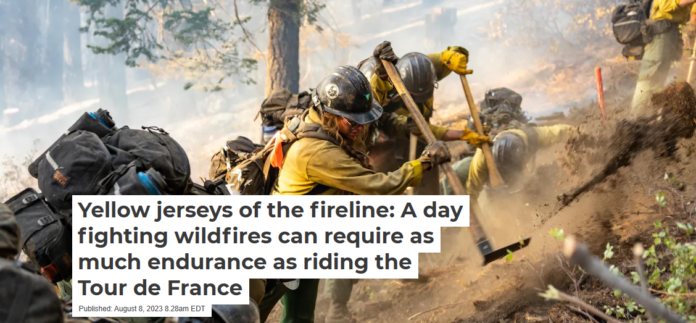
Brent C. Ruby, University of Montana
For three weeks in July, the world’s most elite bike racers climb steep mountains and sprint along historic cobblestones to capture the coveted yellow jersey or the race leader in the Tour de France. It’s a 22-day feat of human endurance that requires constant eating and drinking to manage the average daily energy demand of about 6,000 calories, equivalent to around 12 McDonald’s Happy Meals, and just over 1.5 gallons of water.
Nearly 5,000 miles away in the mountains of North America, radios crackle with chatter from a wildfire incident command post, air operations and other crews fighting a wildfire. Up the fireline, the swings of Pulaskis, axlike hand tools, are carving a fuel break into the land. The weather forecast predicts a high of nearly 100 degrees Fahrenheit (38 C) with wind, a combination that can push the fire high up into the canopy of dense lodgepole pines on the mountainside.
The yellow jerseys here are sooty, sweat-stained and flame-resistant, with a strong, earthy odor.
Hotshot crews like this one are the elite workforce of the forest, and the demand on their bodies can rival that of the cyclists in the Tour de France, as my team’s research shows.
On this morning, the Hotshot crew has already hiked 3 miles up steep, uneven terrain and built nearly 1,200 feet of fire line. It is not yet 10 a.m. The day is just beginning, the first day of a 14-day rollout.
Measuring the physical strain
The dew hangs heavy on the inside of the small tent as the 4:30 a.m. alarm disrupts my intermittent sleep. The sounds of sleeping bag and tent zippers signals the beginning of a new day in a remote Montana fire camp.
Using a headlamp, I arrange the sample collection tubes in a plastic rack and wait for a few members of the Lolo Hotshots to wander through my field laboratory to drop off an early morning urine sample.
The crew is participating in a study that my team from Montana is conducting to measure the physical strain and total energy demands of work on an active wildfire, with the goal of finding ways to improve firefighter fueling strategies and ultimately health and safety on the line.
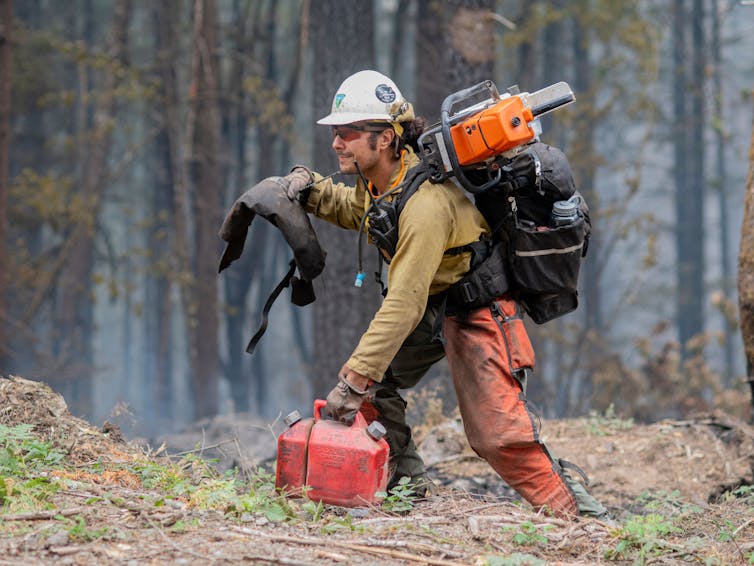
Crew members are outfitted with a series of lightweight monitors that measure heart rate, as well as movement patterns and speed using GPS. Each swallows a temperature-tracking sensor before breakfast that will transmit measures of core body temperature each minute throughout the work shift.
Just before 6 a.m., the crew heads west in their crew carrier rigs into the adjacent wilderness. They have lines to dig and a fire to contain.
Burning 6-14 calories per minute
On the fire line, pack straps dig into the neck and shoulders with each swing of the Pulaski. It’s a constant reminder that everything wildland firefighters need, they carry, all day.
The critical water and food items, supplies, extra gear, and fire line tools – Pulaskis, chain saws, and fuel – add up to an average gear weight often exceeding 50 pounds.
Hiking with a load and digging firelines with hand tools burns about 6 to 14 calories per minute. Heart rates rise in response to an increased pace of digging.
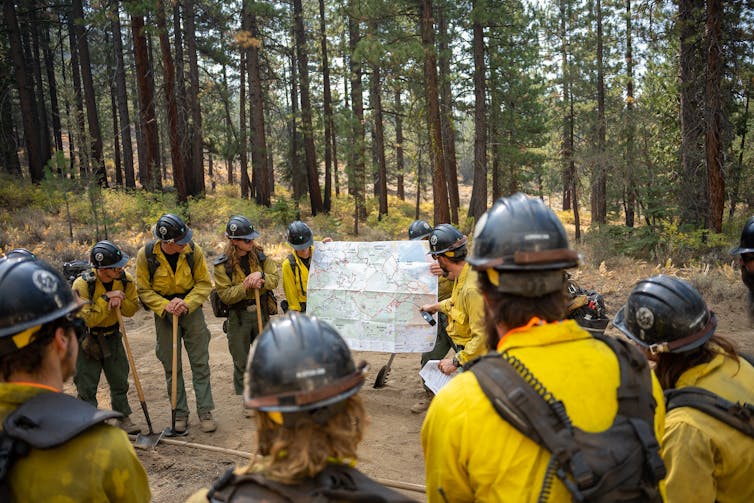
Measured with the same techniques used to quantify the energy demands of Tour de France riders, wildland firefighters demonstrate an average total energy expenditure approaching 4,000 to 5,000 calories per day. Some days can exceed the Tour’s average of about 6,000 calories. Add to that a daily water need of 1.5 to over 2 gallons.
This isn’t just for a few days. Fire season in the western United States can last five months or more, with most Hotshot crews accumulating four to five times the number of operational days of the 22-day Tour de France and over 1,000 hours of overtime.
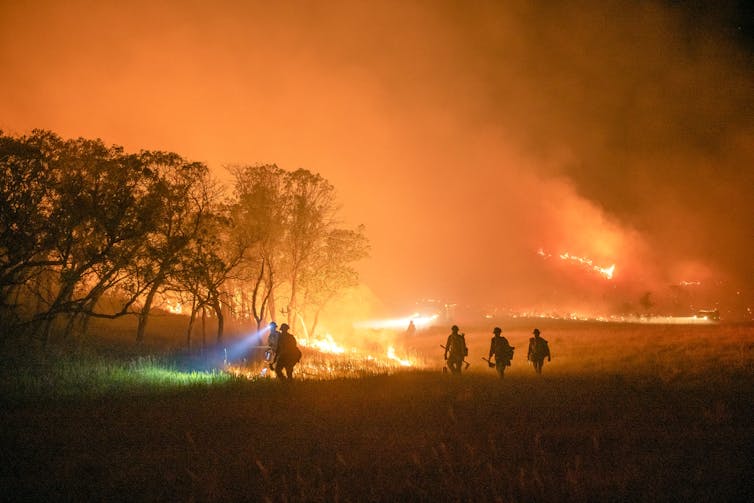
Every year, on average, about 60,000 wildfires will burn across roughly 70 million acres in the western U.S. Drying grasses and forests create fuel for the spark of a lightning strike, power line or carelessly abandoned campfire, and windy summer weather can spread that into a blaze. When those fires could threaten communities, the Hotshots are mobilized.
Impact on the wildland firefighter’s body
As the work shift progresses, the Hotshots constantly monitor their surroundings and self-regulate nutrient and fluid intake, knowing their shift will last 12 to 16 hours.
During intense activity in high heat, their fluid intake can increase to 32 ounces per hour or more.
The highest-intensity activity is generally during the early morning hike to the fire line. However, the metabolic demands can sharply increase if crews are forced into a rapid emergency evacuation from the fire, as more than 25 years of wildland firefighter physiology research shows.
The most effective way for wildland firefighters to stay fueled is to eat small meals frequently throughout the work shift, similar to the patterns perfected by riders in the Tour. This preserves cognitive health, helping firefighters stay focused and sharp for making potentially lifesaving decisions and keenly aware of their ever-dynamic surroundings, and boosts work performance. It also helps slow the depletion of important muscle fuel.
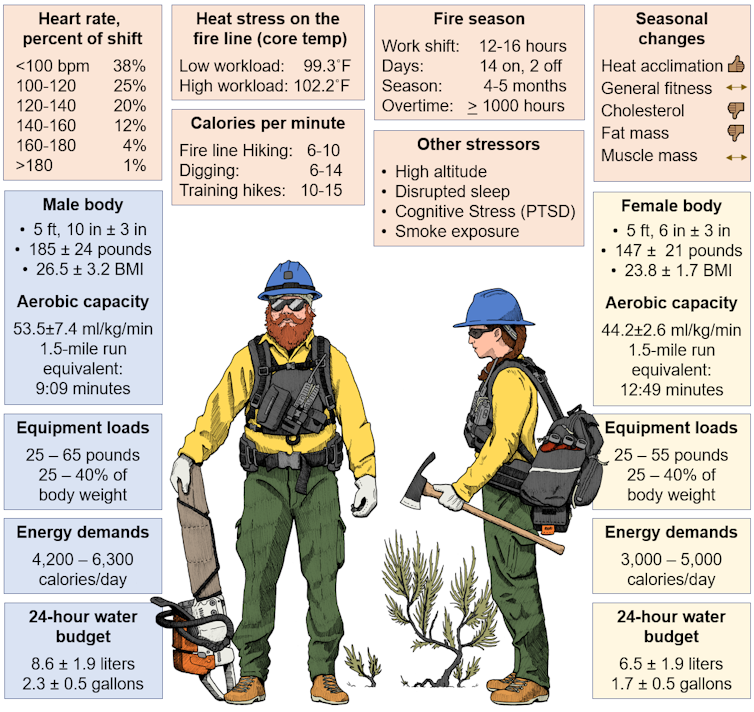
Despite the physical and emotional stress of being in an active fire, the firefighters’ heart rates rarely exceed 160 beats per minute, about 70% to 80% of maximal heart rate and an intensity common during a higher-intensity training run. Their heart rates are mostly maintained between 100 and 140 beats per minute, typical of a brisk walk or hike, but they maintain that for hours.
Although crews gradually acclimatize to the heat over the season, the risk for heat exhaustion is ever present if the work rate is not kept in check. This cannot be prevented by simply drinking more water during long work shifts. However, regular breaks and having a strong aerobic capacity provides some protection by reducing heat stress and overall risk.
The season takes a toll
Hotshots are physically fit, and they train for the fire season just as many athletes train for their competition season. Most crew members are hired temporarily during the fire season – typically from May to October, but expanding as the planet warms. And there are distinct fitness requirements for the job.
Still, with the immense physical demands of the job, crew members often experience a decay in metabolic and cardiovascular health and an increase in cholesterol, blood lipids and body fat. It is unclear why such a hardworking job often makes firefighters less healthy, requiring an off-season reset to recover, retrain and rebuild.
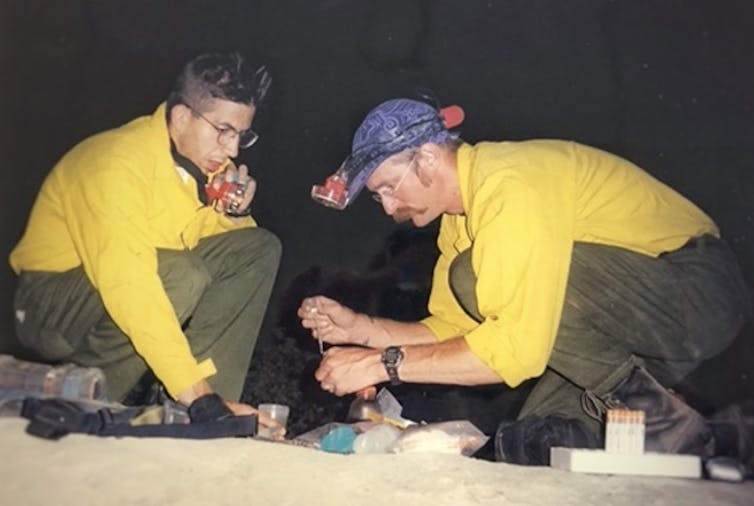
The season causes damage. This unfolds counter to the commonly accepted benefits of regular exercise. Pollutant and smoke exposure, lapses in nutrition, sleep disorders and chronic stress during the season seems to gradually poke holes in the Hotshot armor.
Progressive intervention strategies can help, such as educational programs to inform specific physical training and nutritional needs, mindfulness training to reduce the risk of job-oriented anxiety and depression and emotional support for individual crew members and families.
Developing off-season practices that pay close attention to both physical and mental health recovery can help limit harm to firefighters’ health. Many Hotshots bounce back and return season after season.
Back in camp
A 14-hour intervention with the land is physically and emotionally exhausting.
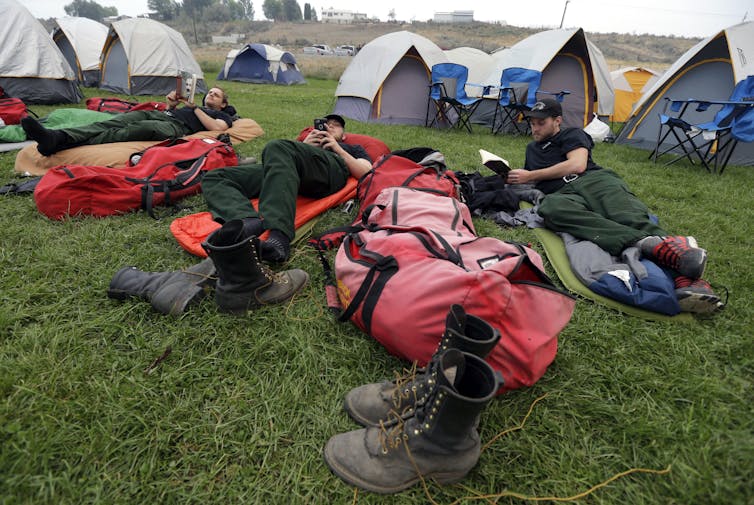
Back in camp, the crew provides another urine sample, and I download their monitors’ data. Their fireline stories have all the elements of American folklore and Western novels, and they bounce between excitement about the events of the day and wondering what the data from their sensors and tests might show. I will use that data combined with our previous research to help crews develop early-season training and advanced nutrition strategies.
A large, warm meal starts to reload precious muscle fuel. In a few hours, a new shift will begin for the Hotshots, and another day in the yellow jersey.
Brent C. Ruby, Research Professor, School of Integrative Physiology and Athletic Training, University of Montana
This article is republished from The Conversation under a Creative Commons license. Read the original article.




